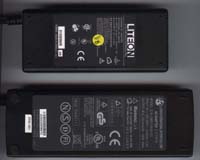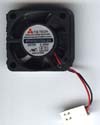Looking at the front of the i-Buddie XP system, we can see that the unit is more rounded than the i-Buddie 4. Again, the front of the unit is bare, as it is home to only the screen release lever and two speaker ports. Our system, an engineering sample, was actually missing the screen release lever. We had to use a screw driver to slide the release to the right but the final version will most certainly not be missing this piece.
The left side of the i-Buddie XP is dominated by cooling vents. There are two ports cut out on this side of the system: one to provide air flow over the voltage regulator and one to provide air flow over the CPU heatsink. On top of the cooling vents, the left side of the system is also home to a modem jack and the unit's power-in port. This setup is slightly different than that of the i-Buddie 4 as the location of the modem port on the i-Buddie XP is actually home to a firewire port on the i-Buddie 4. When we move to the right side of the system you will see that ECS flip-flopped the location of these two components on the i-Buddie XP.
The back of the i-Buddie XP is nearly identical to the back of the i-Buddie 4. The rear of both systems offer an ethernet jack, an s-video out port, a 15-pin VGA out port, a parallel port, an IR window, and two audio jacks, one for audio-in and one for audio-out. Also present on the back of the system is a cooling vent used to aid in air flow across the CPU heatsink. Again, this cooling vent is identical to the one found on the i-Buddie 4. In fact, the only difference between the i-Buddie XP and the i-Buddie 4 except for the color differences is that the i-Buddie XP is slightly more rounded than the i-Buddie 4. This provides for a smoother look to the i-Buddie XP and is a trend we noticed all around the i-Buddie XP.
The right side of the system reveals the one flip-flop that we alluded to earlier. The i-Buddie XP maintains the i-Buddie 4's Kensington lock port and four USB 2.0 ports (stacked two by two side by side) but exchanges the modem jack for a powered 6-pin IEEE-1394 port. The modem jack was moved to the left side of the system in the case of the i-Buddie XP and although we cannot be sure why, it most likely has to do with assembly convenience and little more. The right side of the i-Buddie XP is also home to the unit's optical drive. Our system came configured with an 8X DVD-ROM drive but a DVD/CD-RW drive is an option as well. The drive is slightly different than the one found on the i-Buddie 4 as the face plate is a bit more rounded and is finished in the white glossy paint that covers the bottom half of the system.
Again we find that the bottom of the i-Buddie XP is identical to the i-Buddie 4. Both feature an easily accessible CPU access panel, hard drive panel, and memory panel. The CPU access panel on the i-Buddie XP is slightly larger than that on the i-Buddie 4, making room for the larger Socket A processor at the helm.
The system featured the same large cooling vents on the bottom right side used to provide airflow across the voltage regulator mounted above it. Also present was the large cooling vent on the back right of the system used as an exhaust vent for the air blown across the CPU heatsink.
This location was the place where we were able to get our i-Buddie 4 to a fairly cool running 109.5 degrees Fahrenheit (43.1 degrees Celsius) and we were curious to see how much hotter the system would get with an Athlon XP at the helm. Our test system, running on an Athlon XP 2100+ processor, got up to a sweltering 159.5 degrees Fahrenheit (70.8 degrees Celsius); by far the hottest notebook we have seen. At 159.5 degrees the i-Buddie XP feels like a frying pan when placed on the lap so it is a good thing that the i-Buddie is not a laptop solution but a desknote one. Even so, if there is any time that you may want to have the desknote on your lap, one may find it difficult to do so. On the flip side, it is fairly impressive that ECS was able to provide sufficient cooling for the desktop Athlon XP at high speeds in such a tiny space. Regardless of the exhaust temperature, we had no problem with the i-Buddie XP when it came to CPU temperature or overheating.
Like the i-Buddie 4, the i-Buddie XP uses desktop sized 184 pin DDR SDRAM. Our RAM was rated at PC2100 was 256MB in density.
The i-Buddie XP specifications show it to be the exact same size and weight as the i-Buddie 4: 13.07" x 10.81" x 1.76" and 7.0 pounds. As we mentioned in our i-Buddie 4 review, this is among the largest notebooks we have seen but does not hinder the i-Buddie XP as much as it would if it was designed to be fully mobile.
Being a desknote, the i-Buddie XP includes no battery. As we mentioned in our i-Buddie 4 review, this has its up sides and its down sides but it boils down to the fact that the i-Buddie XP can only be used when tethered to a wall. In the i-Buddie 4 this was problematic only in the fact that we could not use the i-Buddie XP away from a power source but the i-Buddie XP introduces a new issue into the desknote design.
Naturally, when the desknote is being used it has to be plugged into the wall. Power to the system is provided via a transformer that converts the AC electricity from your wall into DC energy that the desknote can use. In the case of the i-Buddie 4, the AC adapter took the wall power and converted it into 19 volts carrying 4.74 amps. The adapter was fairly small and self contained. The i-Buddie XP's AC adapter is a bit different.
First off, the i-Buddie XP's AC adapter is physically larger than that of the i-Buddie 4, making it a bit more cumbersome to carry around. The reason for this is that the i-Buddie XP requires significantly more energy to power it's Athlon XP CPU; this being the second difference between the power adapters. Just like Athlon XP systems require a more powerful power supply in a desktop than a Pentium 4 system, the desktop Athlon XP CPU also requires more power in a desknote solution. The i-Buddie XP's AC adapter outputs 20 volts and carries 6.0 amps. It is because of this high energy output that we encounter a shortcoming of the i-Buddie XP.
The AC adapter included with the i-Buddie XP includes a small fan in the design. Normally a 30x30 millimeter fan would not bother us but the 6,800RPM that the fan in the LiShin International Enterprise Corporation AC adapter that came with our i-Buddie XP was a little much for out liking. The fan makes a slight but audible noise when running, which was the main problem because the fan runs all the time when the AC adapter is plugged into the wall. Regardless of what the AC adapter was doing, putting power to the system or just sitting idle with the system off, as long as it was plugged into the wall the fan on the adapter spins producing a noticeable amount of noise. Although it could not be heard while the i-Buddie XP was on, with the system off and the power supply on the right surface (our desk) the fan made noise and slightly vibrated the power brick creating even more noise. Not a major problem, but it did prove to be irksome and could have been easily solved by turning the fan off along with the desknote or at least providing a switch on the AC adapter to turn it off when not in use.















1 Comments
View All Comments
Anonymous User - Thursday, July 31, 2003 - link
Nice review. By the way, have you heard about the new ECS DeskNote A530 Notebook. Im looking for a review, unfortunately no luck. Maybe you can create a review in the future. Thanks and more power!